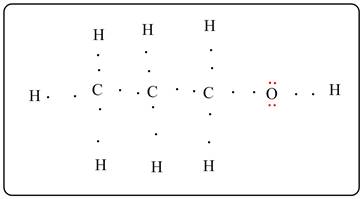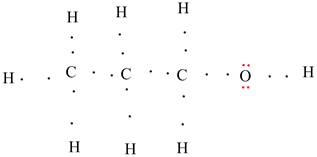
Concept explainers
(a)
Interpretation :
Structural formula of the polar molecule with molecular formula C3H8O must be drawn.
Concept Introduction :
Structural formula represents the structure of a compound in which the arrangements of atoms are shown.
(a)
Answer to Problem 6RE
Structural formula is drawn below for the polar molecule with molecular formula C3H8O.

Explanation of Solution
The molecular formula C3H8O represents isomeric ether and alcohols. Alcohols are polar than ether. Two alcohols are possible with the formula. One is primary alcohol and another is secondary alcohol. Primary alcohol (Propan-1-ol) is drawn.
b)
Interpretation :
Lewis structure must be drawn and shared electrons and lone pair electrons must be labeled.
Concept Introduction :
Lewis dot structure is the representation of molecule in which valence electrons are shown as dots.
b)
Answer to Problem 6RE
Lewis dot structure is given below.

All the dots are bond pair electrons except the two electron pairs on O atom (shown in red) are lone pair electrons.
Explanation of Solution
Lewis electron dot structure is shown. All the carbon is bonded with 4 atoms and the oxygen atom is bonded with two atoms. There are all single bonds. Two lone pairs are there on O atom.
c)
Interpretation :
The dipoles must be identified.
Concept Introduction :
A molecule will have dipoles if there is electronegativity difference between the two atoms forming the bond.
c)
Answer to Problem 6RE
The dipoles are shown.

Explanation of Solution
Oxygen will have partial negative charge as it has more electronegativity. Similarly H atom will have partial positive charge as it has less electronegativity.
Each C-H bond is also a dipole in which C is the negative pole and H is the positive pole as C has more electronegativity as compared to H.
d)
Interpretation :
The geometric shape around each carbon atom must be named.
Concept Introduction :
The geometric shape around an atom depends on the number of total electron pairs.
d)
Answer to Problem 6RE
Each carbon has tetrahedral geometry.
Explanation of Solution
Each carbon is bonded with total 4 atoms including hydrogen atom, carbon atom and oxygen atom. There is no lone pair of electrons on any carbon atom. Thus, each carbon will be tetrahedral.
e)
Interpretation :
The name of the compound must be given with proper reasoning.
Concept Introduction :
A molecule can be named using IUPAC rule. The molecule will have a trivial name also.
The molecule has three carbons and -OH as a
e)
Answer to Problem 6RE
The name of the molecule is Propan-1-ol.
Explanation of Solution
The structure is given as follows:

The numbering is done giving priority to the carbon bearing the functional (-OH) group. Total three carbons are there. The functional group is at carbon 1. So, the IUPAC name is propn-1-ol. The trivial name is n-propyl alcohol. As the -OH group is attached with normal propyl (1 degree) group.
Chapter U2 Solutions
Living by Chemistry
Additional Science Textbook Solutions
Campbell Essential Biology (7th Edition)
Physics for Scientists and Engineers: A Strategic Approach, Vol. 1 (Chs 1-21) (4th Edition)
Microbiology: An Introduction
Anatomy & Physiology (6th Edition)
Campbell Biology (11th Edition)
Biology: Life on Earth with Physiology (11th Edition)
- Complete the reaction in the drawing area below by adding the major products to the right-hand side. If there won't be any products, because nothing will happen under these reaction conditions, check the box under the drawing area instead. Note: if the products contain one or more pairs of enantiomers, don't worry about drawing each enantiomer with dash and wedge bonds. Just draw one molecule to represent each pair of enantiomers, using line bonds at the chiral center. More... No reaction. my ㄖˋ + 1. Na O Me Click and drag to start drawing a structure. 2. H +arrow_forwardPredict the intermediate 1 and final product 2 of this organic reaction: NaOMe H+ + 1 2 H H work up You can draw 1 and 2 in any arrangement you like. Note: if either 1 or 2 consists of a pair of enantiomers, just draw one structure using line bonds instead of 3D (dash and wedge) bonds at the chiral center. Click and drag to start drawing a structure. X $ dmarrow_forwardPredict the major products of this organic reaction: 1. NaH (20°C) 2. CH3Br ? Some notes: • Draw only the major product, or products. You can draw them in any arrangement you like. • Be sure to use wedge and dash bonds where necessary, for example to distinguish between major products that are enantiomers. • If there are no products, just check the box under the drawing area. No reaction. Click and drag to start drawing a structure. G Crarrow_forward
- Predict the major products of this organic reaction: 1. LDA (-78°C) ? 2. Br Some notes: • Draw only the major product, or products. You can draw them in any arrangement you like. . • Be sure to use wedge and dash bonds where necessary, for example to distinguish between major products that are enantiomers. • If there are no products, just check the box under the drawing area. No reaction. Click and drag to start drawing a structure. Xarrow_forwardPlease draw the structuresarrow_forwardDraw the missing intermediates 1 and 2, plus the final product 3, of this synthesis: 0 1. Eto 1. Eto- 1 2 2. MeBr 2. EtBr H3O+ A 3 You can draw the three structures in any arrangement you like. Explanation Check Click and drag to start drawing a structure.arrow_forward
- Draw the missing intermediate 1 and final product 2 of this synthesis: 1. MeO- H3O+ 1 2 2. PrBr Δ You can draw the two structures in any arrangement you like. Click and drag to start drawing a structure.arrow_forwardWhat is the differences between: Glyceride and phosphoglyceride Wax and Fat Soap and Fatty acid HDL and LDL cholesterol Phospho lipids and sphingosine What are the types of lipids? What are the main lipid components of membrane structures? How could lipids play important rules as signaling molecules and building units? The structure variety of lipids makes them to play significant rules in our body, conclude breifly on this statement.arrow_forwardWhat is the differences between DNA and RNA for the following: - structure - function - type What is the meaning of: - replication - transcription - translation show the base pair connection(hydrogen bond) in DNA and RNAarrow_forward
- What is the IP for a amino acid- give an example what are the types of amino acids What are the structures of proteins The N-Terminal analysis by the Edman method shows saralasin contains sarcosine at the N-terminus. Partial hydrolysis of saralasin with dilute hydrochloric acid yields the following fragments: Try-Val-His Sar-Arg-Val His-Pro-Ala Val- Tyr- Val Arg-Val-Tyr What is the structure of saralasin?arrow_forwardWhat is the IP for a amino acid- give an example what are the types of amino acids What are the structures of proteins The N-Terminal analysis by the Edman method shows saralasin contains sarcosine at the N-terminus. Partial hydrolysis of saralasin with dilute hydrochloric acid yields the following fragments: Try-Val-His Sar-Arg-Val His-Pro-Ala Val- Tyr- Val Arg-Val-Tyr What is the structure of saralasin?arrow_forward> aw the missing intermediates 1 and 2, plus the final product 3, of this synthesis: 1. Eto 1. EtO¯ H3O+ 1 2 2. PrBr 2. PrBr Δ You can draw the three structures in any arrangement you like. 3 Click and drag to start drawing a structure. Explanation Check 2025 McGraw Hill LLC. All Rights Reserved. Terms of Use Privacarrow_forward
 ChemistryChemistryISBN:9781305957404Author:Steven S. Zumdahl, Susan A. Zumdahl, Donald J. DeCostePublisher:Cengage Learning
ChemistryChemistryISBN:9781305957404Author:Steven S. Zumdahl, Susan A. Zumdahl, Donald J. DeCostePublisher:Cengage Learning ChemistryChemistryISBN:9781259911156Author:Raymond Chang Dr., Jason Overby ProfessorPublisher:McGraw-Hill Education
ChemistryChemistryISBN:9781259911156Author:Raymond Chang Dr., Jason Overby ProfessorPublisher:McGraw-Hill Education Principles of Instrumental AnalysisChemistryISBN:9781305577213Author:Douglas A. Skoog, F. James Holler, Stanley R. CrouchPublisher:Cengage Learning
Principles of Instrumental AnalysisChemistryISBN:9781305577213Author:Douglas A. Skoog, F. James Holler, Stanley R. CrouchPublisher:Cengage Learning Organic ChemistryChemistryISBN:9780078021558Author:Janice Gorzynski Smith Dr.Publisher:McGraw-Hill Education
Organic ChemistryChemistryISBN:9780078021558Author:Janice Gorzynski Smith Dr.Publisher:McGraw-Hill Education Chemistry: Principles and ReactionsChemistryISBN:9781305079373Author:William L. Masterton, Cecile N. HurleyPublisher:Cengage Learning
Chemistry: Principles and ReactionsChemistryISBN:9781305079373Author:William L. Masterton, Cecile N. HurleyPublisher:Cengage Learning Elementary Principles of Chemical Processes, Bind...ChemistryISBN:9781118431221Author:Richard M. Felder, Ronald W. Rousseau, Lisa G. BullardPublisher:WILEY
Elementary Principles of Chemical Processes, Bind...ChemistryISBN:9781118431221Author:Richard M. Felder, Ronald W. Rousseau, Lisa G. BullardPublisher:WILEY





